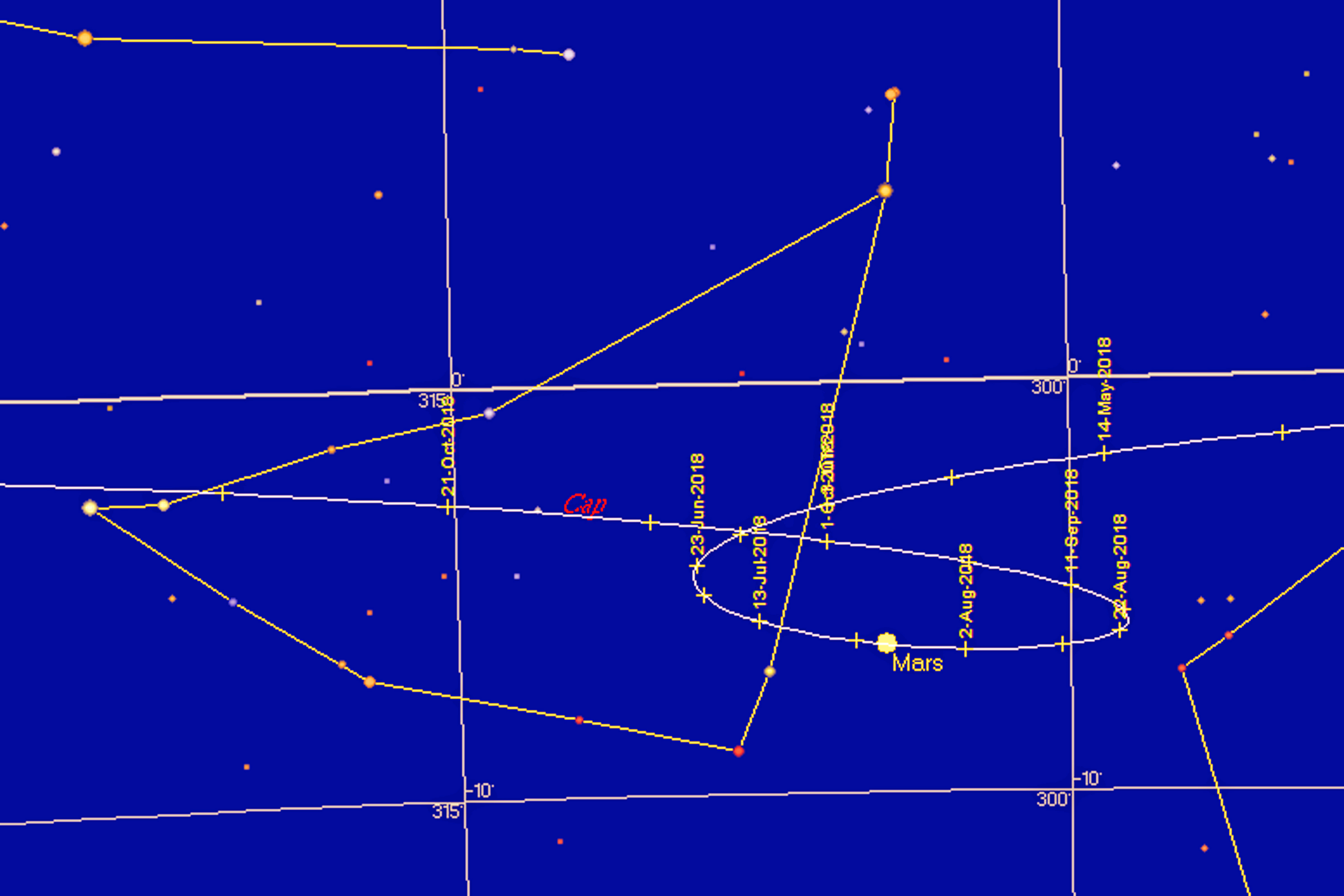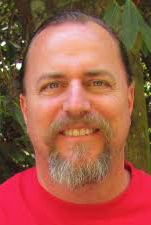| 2018 Mars Retrograde in Capricorn |
by Gary P. Caton, 2018 Celestial Planting Calendar
This year the retrograde motion of Mars is just as extrodinary as the Venus retrograde. Like Venus, Mars alternates between closer to Earth than the Sun and farther away. It is when Mars is closest to Earth that we experience the apparent retrograde. At perihelion Mars is extremely bright, and can actually be brighter than Jupiter, and much brighter than any star. However, because of Mars’ mildly eccentric orbit (shaped more like a slightly flattened circle) all of these perigees are not created equal. On July 27, 2018 Mars achieves what astronomers call “perihelic opposition,” meaning that perigee (Mars’ closest approach to Earth) and perihelion (Mars closest approach to the Sun) combine to bring Mars closer and brighter than it has been since 2003. (Note: a total lunar eclipse also occurs on that same day.)
Rudolf Steiner tells us that Mars (along with Jupiter and Saturn) belongs to the group of planets farther from Earth which work via silica in the soil, respond to heat and activate the food-bearing parts of the plant. Maria Thun, after her extensive research, assigns Mars to the Water/Damp ether (along with the Moon) which corresponds to the leafy parts of the plant. It seems to me that the effects of Mars are more earthy in the closer part of its orbit, and conversely, more cosmic farther away.

As Mars retrograde occurs when it is closest to Earth, then it would seem a good time to work with the soil, testing and remediating it for proper balance. This “below” part of the agricultural work especially applies to this particular Mars retrograde. Over the course of 15 to 17 years, Mars will retrograde seven times. Each of these retrogrades has its own particular shaped loop in the sky. However, because of its eccentric orbit, Mars retrogrades much less frequently in the loops which have a shape where Mars loops downward into south latitude, below the ecliptic. This particular retrograde is one of the rarer “below” shaped loops. It should be noted that Steiner associated the sky forces with silica, so possibly that dimension might also be considered during this Mars retrograde.
This would seem a valued opportunity to work with the more earthy side of Mars, as it relates not only to the earth/water ethers and root/leaf functions, but also to soil composition.
 Gary P. Caton - Astronomer, Writer, Forecaster Gary P. Caton - Astronomer, Writer, Forecaster
Growing up in a rural setting outside Leesburg, Virginia, Gary developed passions for gardening and farming early in life and has lived on working farms.
In 1993 Gary was initiated into the planetary mysteries by seeing alignments in a dream. His deep love of nature fuels his enthusiasm for stargazing and astrophotography. Gary claims it has been a true joy combining his lifelong passion for learning with the tasks of completing the calculations and contributing to the forecasts for this calendar. Based on more than two decades of experience, he incorporates several new elements into this text, including consideration of the sextile aspect and a look at the deeper mysteries of the retrograde loops of Venus and Mars.
www.dreamastrologer.com
|
|
|
| 2018 Venus Retrograde in Virgo |
by Gary P. Caton, 2018 Celestial Planting Calendar
The apparent retrograde motion of the planets is an interesting natural phenomena. The word “planet” is derived from the Greek word “planētēs” meaning “wanderer.” And while it is natural for those who wander to backtrack from time to time, it remains a genuine mystery for many just what the deeper meaning of these backward celestial wanderings could be. In particular, Venus is the planet that is most rarely found moving backward. Venus is retrograde for only about 40-43 days of its 584 day synodic cycle, or about 7-8% of the time. This gives an important clue. Retrograde motion is at strong variance to what is usual or “normal.” Coincidentally, it just so happened that Steiner gave his groundbreaking Agriculture Course in June of 1924, at a time of one of these relatively rare Venus retrogrades.
One of the things I really love about the Biodynamic system is that it derives planetary functions directly from the astronomy, and in this way we can use further astronomical observation to gain deeper insight into the retrograde mysteries. In the very first lecture of the Agriculture Course, Steiner tells us that Venus (along with Mercury and the Moon) belongs to the group of planets closer to Earth which work via limestone in the soil, respond to water and activate the reproductive parts of the plant.
More recently, George Schmidt and his coworkers divided the planets into three groups, those near, far and “wechsel” or alternating. This concept is based on the Earth-Sun distance of approximately 93 million miles, also known as the astronomical unit (AU). Jupiter and Saturn are always further from the Earth than one astronomical unit, with the Moon and Sun being conversely relatively near. But Mercury, Venus and Mars are sometimes closer to the Earth than the Sun, and sometimes farther. It is in their periods of closeness that they appear retrograde.

For instance, at the inferior conjunction (from Latin inferius, meaning “below”) with the Sun, Venus is a mere 24-25 million miles from Earth, less than 1/3 AU. At superior conjunction (from Latin superius, meaning “above”), Venus is more than six times farther, about 162 million miles.
When Venus is closest to Earth we experience the apparent retrograde, as Earth is being passed by the speedier planet. Venus is invisible to us at this time because it is too close to the Sun, but a mere 36 days on either side of the inferior conjunction marks its brightest apparitions. Here Venus is only in crescent phase, but because of its proximity to Earth it appears larger, such that its illumination is greater than its much smaller “Full” phase Venus.
The turning points in Venus’ relationship to Earth occur around her elongations. When Venus reaches Greatest Western Elongation (morning elongation), her daily eastern speed as seen from Earth becomes greater than that of the Sun, and the planet moves in the prograde direction as it moves further away from Earth. When Venus approaches Greatest Eastern Elongation (evening elongation), her daily eastern speed decreases and eventually reverses. The planet then begins to move in the retrograde direction as it starts moving closer to Earth. Venus’ evening elongation this year is on August 17 and her morning elongation will be in January 2019.
Now that we understand Venus’ alternating nature astronomically, let us apply it to the Biodynamic system. In lecture one of the Agricultural Course, Steiner tells us that Venus, along with Mercury and the Moon, belong to the group of planets closer to Earth which work via limestone in the soil, respond to water and activate the reproductive parts of plants. Maria Thun assigns Venus to the Light/Air ether which corresponds to flowering parts.
How can we reconcile these positions? It seems to me that the effects of Venus are more earthy in the closer part of its orbit namely the “inferior phase” (from evening elongation through inferior conjunction to morning elongation). And conversely, Venus takes on a more cosmic energy in the further parts of its orbit, what we call the “superior phase” (from morning elongation through superior conjunction to evening elongation).
In practical terms, if “inferior” means “below,” then Venus’ inferior phase, especially during retrograde when Venus is closest to Earth, may be a suitable time for working with the soil itself, testing it and remediating for proper balance – particularly with respect to the minerals calcium and magnesium which limestone provides. When we map the celestial motion of Venus, there is further reason to think that this “below” part of the agricultural work especially applies to this particular Venus retrograde, which occurs this year between October 5 and November 16.
Over the course of eight years, Venus retrogrades five times. Each of these retrogrades has its own particular shaped loop in the sky. Only two of these loops have a shape where Venus loops downward into the southern latitude, below the ecliptic. This 2018 retrograde is one of the “below” shaped loops. Venus will be significantly below the ecliptic (that is, lower than any of the stars in Virgo) not only during its retrograde, but for all of September, October and the first week of November. This is a rare moment to work with the earthy side of Venus, as it relates to the Earth/Water, reproduction and Root/Leaf functions, and also to soil.
 Gary P. Caton - Astronomer, Writer, Forecaster Gary P. Caton - Astronomer, Writer, Forecaster
Growing up in a rural setting outside Leesburg, Virginia, Gary developed passions for gardening and farming early in life and has lived on working farms.
In 1993 Gary was initiated into the planetary mysteries by seeing alignments in a dream. His deep love of nature fuels his enthusiasm for stargazing and astrophotography. Gary claims it has been a true joy combining his lifelong passion for learning with the tasks of completing the calculations and contributing to the forecasts for this calendar. Based on more than two decades of experience, he incorporates several new elements into this text, including consideration of the sextile aspect and a look at the deeper mysteries of the retrograde loops of Venus and Mars.
www.dreamastrologer.com
|
|
|
| Water Consciousness |
by Rosemary Tayler, Celestial Planting Calendar 2018
 Much like homeopaths and biodynamic prep makers, Masaru Emoto (1943-2014) held a fascination with water to such a degree that he believed water had memory and healing powers. He claimed its quality could be influenced by certain external factors. Over many years he developed a healing technique called HADO (Healing and Discovering Ourselves) which he claimed was “the energy or vibration inherent in all things.” To visually demonstrate this belief, he refined equipment to take photographs of water crystals obtained from a variety of pure or contaminated of water sources and crystals of water exposed to specific English or Japanese words. Gradually these teachings were compiled into several books which were translated into some 23 languages. Much like homeopaths and biodynamic prep makers, Masaru Emoto (1943-2014) held a fascination with water to such a degree that he believed water had memory and healing powers. He claimed its quality could be influenced by certain external factors. Over many years he developed a healing technique called HADO (Healing and Discovering Ourselves) which he claimed was “the energy or vibration inherent in all things.” To visually demonstrate this belief, he refined equipment to take photographs of water crystals obtained from a variety of pure or contaminated of water sources and crystals of water exposed to specific English or Japanese words. Gradually these teachings were compiled into several books which were translated into some 23 languages.
In his book The True Power of Water, Emoto asks, “Do you know your consciousness has the ability to change water? When you send your gratitude to water, its quality improves.”
In his book, Love Thyself, The Message from Water III, Emoto asks another question: “How can we know how the power of prayer works? I can’t explain the mechanism. The only thing that I can say with confidence, is that when it works in the water, it actually alters its structure. This means that we’ve proven that physical energy can change in accordance with our wishes. I’ve become absolutely convinced of this after carrying out so many experiments where we’ve prayed over water and actually transformed its crystals into more beautiful forms.”
Hiromasa Emoto, Masaru’s son, offers the following insights about the water crystal experiment at Fujiwara dam in 1998: “The dam water was polluted, but because of a healing prayer, the water really changed. Even the surface of the dam water started to look clear. The sample was taken to the laboratory and his staff looked at it through the microscope; there was one amazing and stunning water crystal found. [see image below] I am sure that this water crystal image really changed my father’s life.”
Sending thoughts of love and gratitude for water is a teaching for which Mr. Emoto is remembered.
Rosemary Tayler - Writer, Editor
Rosemary has a background in biochemistry, marine biology (MSc) and alternative medicine, in particular, homeopathy. She has also extensively studied astrology. From 2000 to 2015 she devoted time to establishing community gardens, composting and organizing local food markets in Ottawa, Ontario.
|
|
|
| Super Moon Phenomenon |
by Gary P Caton, 2018 Celestial Planting Calendar
At the heart of the Celestial Planting Calendar’s methodology, and indeed the biodynamic movement as a whole, is the pioneering material delivered in 1924 by Rudolf Steiner in a series of lectures known as the Agriculture Course. In the very first lecture, Steiner tells us that: “In deed and in truth, with the forces that come from the Moon on days of the Full Moon, something colossal is taking place on Earth.”

The most obvious effect of the Moon on the Earth is the tides, and in fact at times of alignment between Earth, Sun and Moon, known technically as “syzygy” and commonly as New and Full Moons, the tides are more pronounced. The tides which accompany a New or Full Moon are known as “spring tides,” referring to their “springing forth” or more pronounced effect. The most pronounced tides of all come when the New or Full Moon occurs near lunar perigee, as the Moon is in the part of its orbit closest to Earth (peri means “close” and gee refers to Earth). These most pronounced tides are known as perigean spring tides.
The SuperMoon phenomenon is directly related to these perigean spring tides. SuperMoon is simply a popular name for what astronomers call a perigee-syzygy – a New or Full Moon closely coinciding with lunar perigee. Astrologer Richard Nolle coined the term SuperMoon back in September 1979, in an article for Dell Horoscope magazine in which Nolle made an accurate prediction for a spectacular storm which did indeed occur and became known as Hurricane David. Nolle asserted that the SuperMoon is “a strong signal of geophysical disturbances – tidal surges in Earth’s atmosphere, oceans and crust that correspond to severe storms, unusually high tides, and moderate to severe seismic activity, including volcanic eruptions as well as earthquakes.” Nolle gave a 6-day window (3 days before and after syzygy) for these events and cited numerous other examples.
If Steiner tells us that a normal Full Moon has colossal effects on Earth, then it simply makes good common sense that a New or Full Moon also occurring at perigee, closest approach to Earth, would have an even more pronounced effect. And we can indeed see these effects in the perigean spring tides. And just as Steiner tells us that the forces of the Full Moon work through water, we can see in the historical record numerous examples of storms that grow to monstrous proportions when accompanied by a SuperMoon. In terms of biodynamics, it seems the effects of even a simple lunar perigee are a bit too pronounced for planting and harvesting times. This is why you see the times around lunar perigee blocked out as unfavorable each month in the Celestial Planting Calendar. Given the correspondence of drastic natural events with Supermoons, it seems these times are even more unfavorable than simple perigee. Starting in December 2017, there are three SuperMoons in row, with the Full Moon in January being the most powerful. Looking at the columns on the left of the Celestial Planting Calendar, we see that lunar perigee and Full Moon both occur on January 1. Not only this, but the Moon is near a declinational extreme with respect to the celestial equator, that is, the Moon moves from ascending to descending only a couple hours after the Full Moon. This means that this Full Moon will also be very high in the sky.
Every so often we have a SuperMoon which is extreme, even in terms of this already extreme phenomenon. The Full Moon and perigee align most closely in periods of about 413 days (one year and 48 days). The January 1 Supermoon is one of these extreme SuperMoons, as it will be several thousand kilometers closer to Earth than the “average” SuperMoon. The last SuperMoon that was this close to Earth was on November 14, 2016. I managed to take the accompanying photo of it. What a sight to see!
I did some research regarding extreme weather in mid-November 2016, and I found it was an extremely warm and dry month, bringing severe drought conditions to large and multiple parts of North America. This is very interesting considering this was the closest SuperMoon in 68 years and it was in the constellation Aries, part of the fire/warmth trigon. More research into the constellation placements of SuperMoons might be warranted. In a brief perusal of the historical highlights, I did notice a few notable hurricanes occurring near SuperMoons in Aquarius. If there is indeed any kind of “trigon effect,” then we would expect high winds to be the driving force of any extreme weather around January 1, as the SuperMoon is in Gemini, part of the Air trigon.
The second Full Moon of January is also a total Lunar Eclipse. This eclipse occurs in the early morning in North America and the Blood Moon Phase (caused by sunlight refracted through the Earth’s atmosphere) will only be visible at moonset and from the Central Time Zone. Eclipses are also notorious for unusual and extreme events, both astrophysical and sociocultural. These can happen anywhere in the world.
While we won’t always see extreme events at every SuperMoon or eclipse, it still might be a good idea to make reasonable preparations for extreme weather conditions at these times, especially if one is traveling or lives in areas where extreme weather is likely. Having an emergency plan and supplies are good common sense. And if the SuperMoons do nothing else than give us beautiful sights to gaze at or remind us to refresh and update our emergency plans, there is nothing wrong with that.
 Gary P. Caton - Astronomer, Writer, Forecaster Gary P. Caton - Astronomer, Writer, Forecaster
Growing up in a rural setting outside Leesburg, Virginia, Gary developed passions for gardening and farming early in life and has lived on working farms.
In 1993 Gary was initiated into the planetary mysteries by seeing alignments in a dream. His deep love of nature fuels his enthusiasm for stargazing and astrophotography. Gary claims it has been a true joy combining his lifelong passion for learning with the tasks of completing the calculations and contributing to the forecasts for this calendar. Based on more than two decades of experience, he incorporates several new elements into this text, including consideration of the sextile aspect and a look at the deeper mysteries of the retrograde loops of Venus and Mars.
www.dreamastrologer.com
|
|
|
|
|


![]()


 Gary P. Caton - Astronomer, Writer, Forecaster
Gary P. Caton - Astronomer, Writer, Forecaster
 Much like homeopaths and biodynamic prep makers, Masaru Emoto (1943-2014) held a fascination with water to such a degree that he believed water had memory and healing powers. He claimed its quality could be influenced by certain external factors. Over many years he developed a healing technique called HADO (Healing and Discovering Ourselves) which he claimed was “the energy or vibration inherent in all things.” To visually demonstrate this belief, he refined equipment to take photographs of water crystals obtained from a variety of pure or contaminated of water sources and crystals of water exposed to specific English or Japanese words. Gradually these teachings were compiled into several books which were translated into some 23 languages.
Much like homeopaths and biodynamic prep makers, Masaru Emoto (1943-2014) held a fascination with water to such a degree that he believed water had memory and healing powers. He claimed its quality could be influenced by certain external factors. Over many years he developed a healing technique called HADO (Healing and Discovering Ourselves) which he claimed was “the energy or vibration inherent in all things.” To visually demonstrate this belief, he refined equipment to take photographs of water crystals obtained from a variety of pure or contaminated of water sources and crystals of water exposed to specific English or Japanese words. Gradually these teachings were compiled into several books which were translated into some 23 languages.